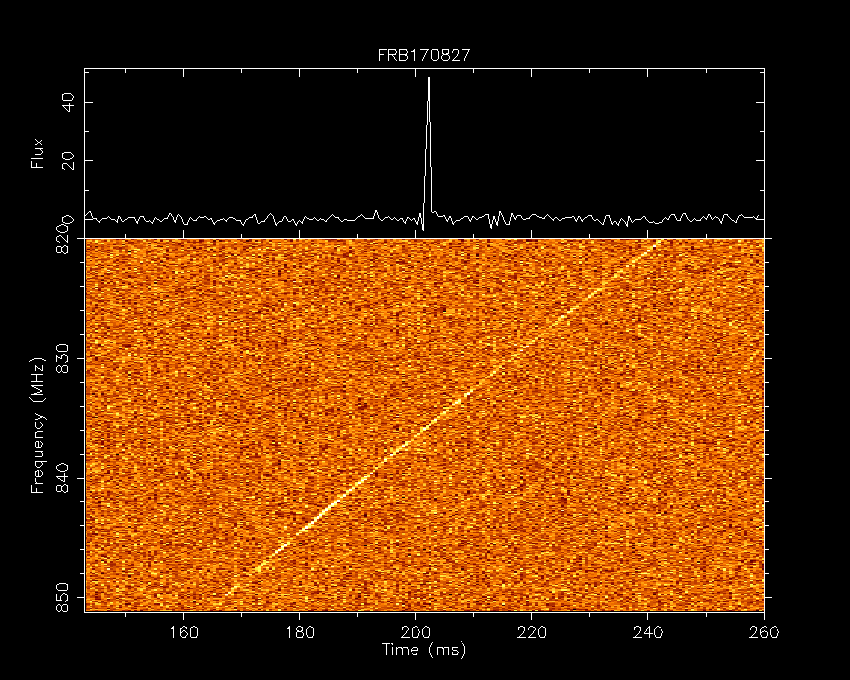Fast Radio Bursts – Frequently Asked Questions
What is a Fast Radio Burst (FRB)?
FRBs are extremely bright flashes of energy seen by radio telescopes and lasting for only a few milliseconds or less. Many thousands are taking place daily over the whole sky, and come from galaxies in the distant universe. The cause of these events remains unknown.

When were FRBs discovered?
In 2007. Radio astronomers Duncan Lorimer and Matthew Bailes were searching in archival data from the Parkes Radio Telescope in Australia. The researchers accidentally stumbled upon a radio burst that appeared to originate from distant realms of the universe.
Why did we not find FRBs earlier?
Radio telescopes with enough search area on the sky, high time resolution and computational power were developed in the early 2000s. These signals are so brief — just a few milliseconds — that all these resources were needed to find them.
How have more FRBs been found?
Initially, FRBs were found as a (welcome!) side product of searches directed at other astronomical objects. Once FRBs were well enough understood, surveys were designed targeting them explicitly, using the most sensitive and wide coverage radio telescopes available.
How many FRBs are known?
Until mid-2018, only a few tens of FRBs were known. In late 2018, astronomers at the ASKAP radio observatory in Western Australia found 25 more. In early 2019, dozens more events were reported by the brand new CHIME telescope in Canada, bringing the total number of FRBs to closer to 100. We expect 1000s of FRBs to be discovered over the next few years.
How often do FRBs occur?
We estimate that thousands of FRBs occur every day — or one every few minutes — which would be detectable with our most sensitive radio telescopes. Wide area telescopes have been built to catch more of them, such as UTMOST and ASKAP in Australia and CHIME in Canada.
Where do we see FRBs in the sky?
Everywhere! So far there is no evidence indicating that FRBs come from any particular direction.
At what frequencies are FRBs visible?
FRBs have only been found in radio frequencies so far, i.e. the same frequencies at which our mobile phones work. Despite huge efforts by astronomers world-wide, no FRB has been seen yet at any other wavelength.
How far away are FRBs?
FRBs appear to be coming from hundreds of millions to billions of light-years away — up to half-way across the universe. The signal can take billions of years to reach the Earth.
How much energy do FRBs release?
FRBs release huge amounts of energy — and are amongst the most powerful sources known. In a few milliseconds, they can emit as much energy as produced by the Sun in a day!
What can FRBs be used for?
A remarkable possibility is that FRBs could be used to “weigh the universe” – the signal probes all the matter between the Earth and the FRB. They could also be used to measure the magnetic field strength between galaxies in the distant universe.
Are FRBs one-off signals or do they repeat?
Only 2 out of the ~90 FRBs discovered to date have been seen to sporadically repeat, while others, despite the tremendous effort and telescope time, were never observed to recur. Maybe all FRBs repeat at some point in their life-time, only time, and more observations will tell.
What causes FRBs?
This has been one of the biggest mysteries in the FRB field, even 10 years after their discovery. But this doesn’t stop us from trying to guess: possible FRB progenitor models include collisions of dense and massive objects like white dwarfs, neutron stars or even black holes. Astronomers have also been pointing fingers at magnetars – highly magnetised spinning neutron stars – as possible producers of FRBs. There are dozens of suggestions for what FRBs are – we definitely need to find more.